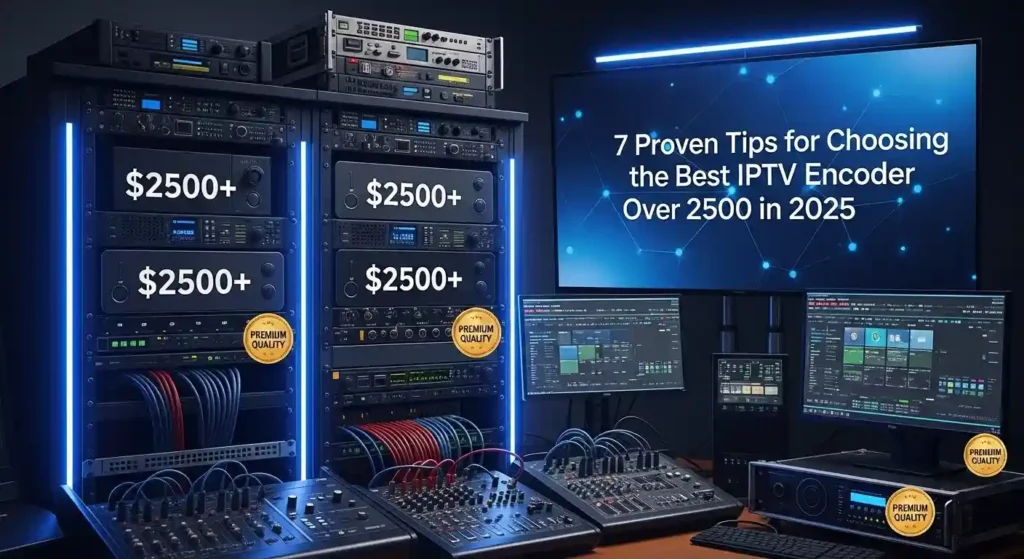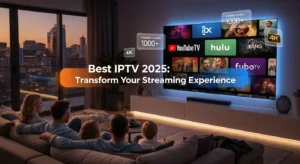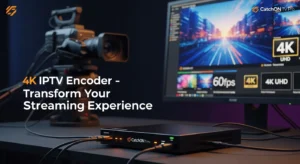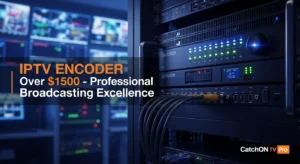Introduction: Why the Right IPTV Encoder Over 2500 Matters in 2025
An IPTV encoder over 2500 is the backbone of any high-quality streaming setup that demands professional reliability, ultra-low latency streaming, and consistent broadcast performance. Whether you’re an IPTV reseller managing multiple channels, a broadcaster delivering live content to thousands of viewers, or a content creator building a premium streaming service, selecting the right encoder directly impacts your uptime, viewer satisfaction, and long-term success.
The IPTV landscape has evolved dramatically in 2025, with viewers expecting 4K streams, sub-second latency, and flawless multi-protocol broadcast capabilities. A subpar encoder choice can result in buffering issues, dropped connections, and frustrated audiences who quickly switch to competitors. Conversely, investing in the right IPTV encoder over 2500 ensures your streaming infrastructure can handle peak traffic loads while maintaining broadcast-quality output across SRT, HLS, and RTMP protocols.
Professional streaming operations require encoders that deliver consistent performance under demanding conditions. The investment in an IPTV encoder over 2500 represents a critical decision that affects every aspect of your streaming workflow, from initial video signal capture to final delivery optimization. Modern viewers have zero tolerance for quality issues, making encoder selection one of the most important infrastructure decisions you’ll make.
This comprehensive guide provides seven proven tips from streaming engineers and IPTV professionals to help you make an informed encoder selection that aligns with your technical requirements and budget constraints while future-proofing your streaming operations.
Table of Contents
Understanding IPTV Encoders: Hardware vs. Software Architecture
How IPTV Encoders Work in Modern Streaming Infrastructure
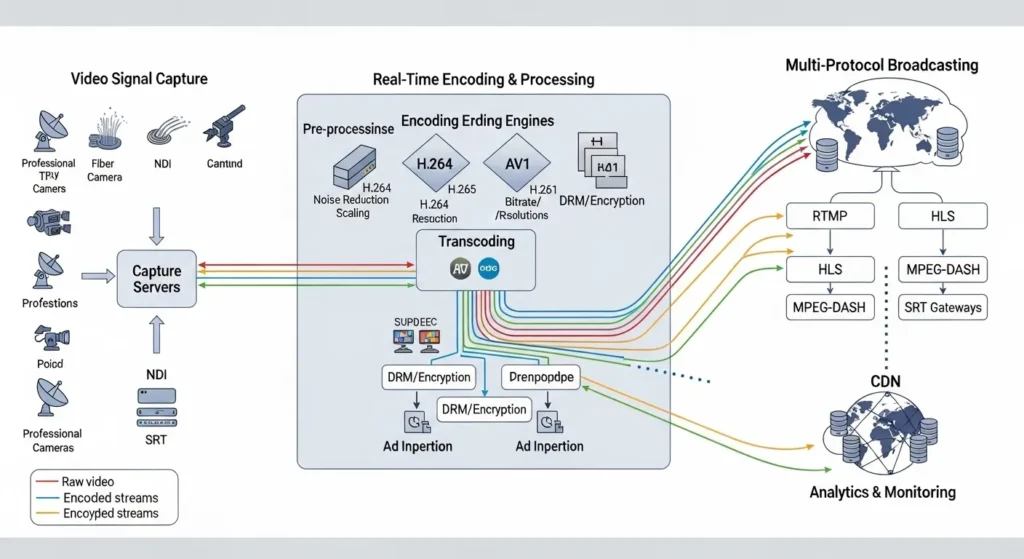
IPTV encoders serve as the critical bridge between your video signal capture devices and your streaming distribution network. They compress raw video feeds into digital formats optimized for internet delivery while maintaining quality standards your audience expects. The encoding process involves capturing incoming video signals, applying compression algorithms (typically H.264 or H.265), and packaging the stream for real-time encoding across multiple output protocols.
Modern encoders handle increasingly complex tasks in today’s streaming environment. These systems must process high-resolution content while maintaining low latency and supporting multiple simultaneous outputs. Advanced encoders incorporate artificial intelligence for adaptive bitrate streaming, ensuring optimal quality regardless of viewer connection speeds or device capabilities.
The encoding workflow begins with video signal capture from various input sources including SDI cameras, HDMI devices, and IP-based streams. Professional encoders then apply sophisticated compression algorithms that balance file size reduction with quality preservation. This process requires significant computational power, especially when handling 4K content or multiple simultaneous streams.
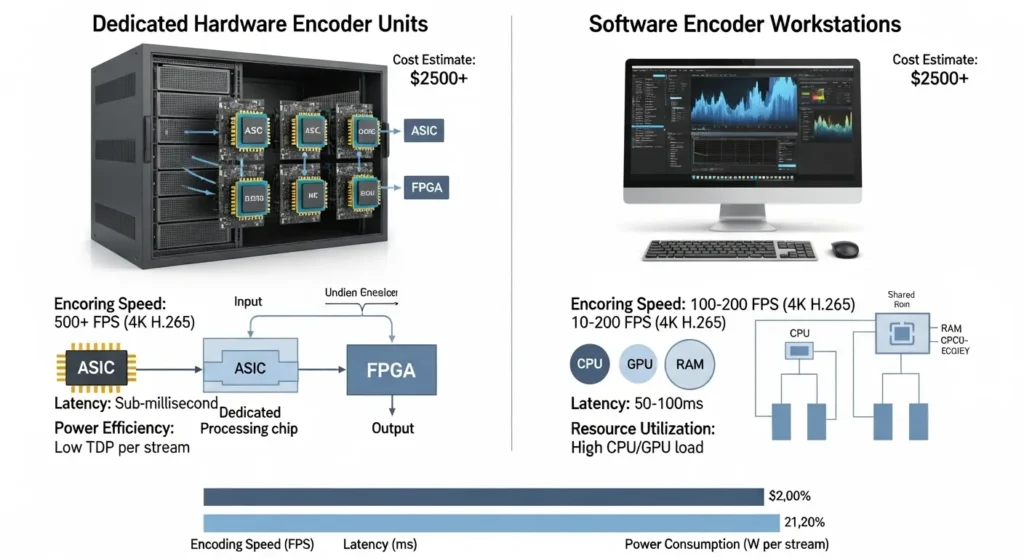
Hardware Encoders: Comprehensive Analysis
Performance Advantages: Hardware encoders provide dedicated processing power that ensures consistent performance regardless of system load. These units feature specialized chips designed specifically for video compression, delivering superior efficiency compared to general-purpose processors. The dedicated hardware architecture eliminates resource conflicts that can affect software-based solutions running on shared systems.
Professional hardware encoders include built-in cooling systems engineered for continuous operation. These thermal management systems maintain optimal operating temperatures during extended broadcasting sessions, preventing performance degradation that occurs when components overheat. Advanced models feature intelligent fan control that adjusts cooling based on real-time temperature monitoring.
Operational Considerations: Hardware encoders require physical rack space and dedicated power connections, making facility planning essential. However, their standalone operation reduces dependencies on other systems, creating more predictable performance characteristics. Many professional broadcasters prefer hardware solutions for mission-critical applications where reliability outweighs flexibility concerns.
Software Encoders: Detailed Evaluation
Flexibility Benefits: Software encoders offer unmatched flexibility for rapidly changing streaming requirements. Updates deploy quickly without hardware replacements, ensuring access to latest protocols and compression improvements. Cloud-based software encoders scale dynamically, accommodating traffic spikes without manual intervention or physical infrastructure changes.
Modern software encoders leverage GPU acceleration to achieve performance levels approaching dedicated hardware while maintaining software flexibility. This hybrid approach provides efficient processing power with the adaptability needed for diverse streaming scenarios.
Implementation Challenges: Software encoders demand significant server resources, particularly CPU and memory for high-quality streams. Proper sizing calculations must account for encoder resource requirements alongside other applications running on shared systems. Inadequate resource allocation leads to dropped frames, quality degradation, and viewer complaints.
Network dependencies create potential failure points that don’t exist with standalone hardware solutions. Internet connectivity issues, server failures, or cloud provider outages can disrupt encoding operations, making redundancy planning essential for professional deployments.
Key Features to Look For in a Modern IPTV Encoder Over 2500
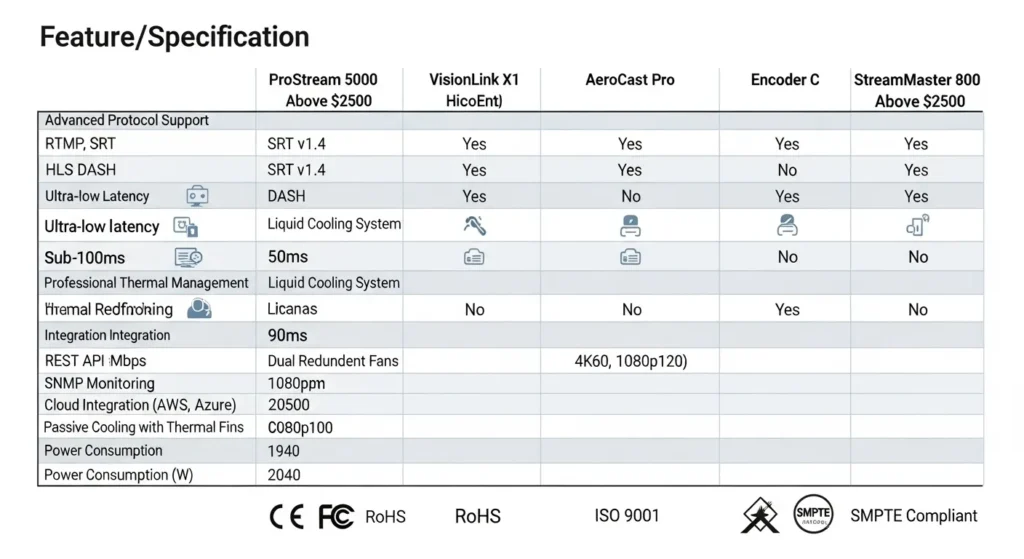
Advanced Protocol Support and Future Compatibility
Your IPTV encoder over 2500 investment should support comprehensive protocol compatibility that accommodates current requirements while preparing for future streaming standards. Essential protocols include RTMP for social media integration, SRT for reliable long-distance transmission with error correction, and HLS for adaptive bitrate streaming that optimizes quality based on viewer connection speeds.
Modern encoders must also support emerging protocols like WebRTC for ultra-low latency interactive streaming and DASH for improved mobile device compatibility. Protocol support directly impacts your ability to reach diverse audiences across different platforms and devices without requiring multiple encoding systems.
Consider encoders with protocol transcoding capabilities that convert between different streaming standards automatically. This feature enables single-source encoding with multiple output formats, reducing infrastructure complexity while expanding distribution options.
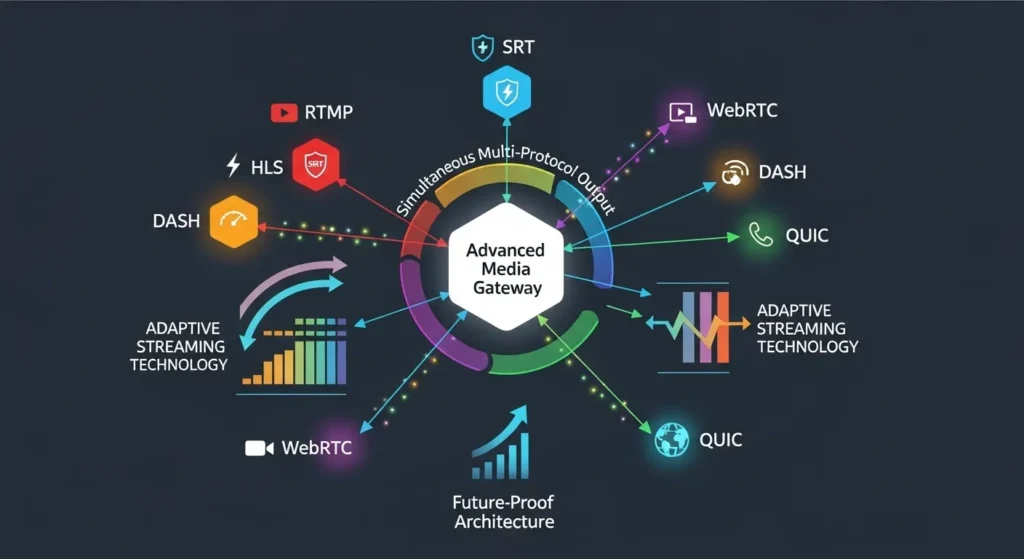
Advanced encoders include protocol-specific optimization features that improve performance for each streaming standard. SRT implementations should include adaptive bitrate adjustment based on network conditions, while HLS outputs should support multiple quality tiers for adaptive streaming.
Ultra-Low Latency Performance Optimization
Latency performance directly affects viewer engagement, particularly for live sports, gaming streams, interactive content, and real-time communications. Professional-grade encoders should deliver sub-500ms latency for RTMP streams and under 2 seconds for HLS delivery while maintaining consistent quality standards.
Test potential IPTV encoder over 2500 candidates under realistic traffic conditions to validate latency claims. Marketing specifications often reflect ideal laboratory conditions rather than real-world performance with network congestion and varying input signal quality.
Advanced encoders implement predictive buffering that anticipates network conditions and adjusts streaming parameters proactively. This intelligence reduces buffering events while maintaining low latency, creating smoother viewing experiences that keep audiences engaged.
Look for encoders with latency monitoring tools that provide real-time feedback about streaming performance. These metrics help optimize configurations and identify potential issues before they affect viewer experience.
Professional Thermal Management and Reliability
Extended operation generates significant heat that can degrade performance and reduce equipment lifespan without proper thermal management. Professional IPTV encoder over 2500 models feature sophisticated cooling systems with redundant fans, temperature sensors, and intelligent thermal control algorithms.
Evaluate cooling system design including airflow patterns, noise levels for studio environments, and maintenance requirements. Quality encoders include easily replaceable fans and filters that extend operational life while minimizing downtime for maintenance.
Power efficiency directly impacts operational costs and heat generation. Look for encoders with power management features that reduce consumption during lighter workloads while maintaining full performance capability when needed. Energy-efficient designs also reduce cooling requirements and infrastructure costs.
Consider environmental monitoring capabilities that track temperature, humidity, and power consumption in real-time. These features enable proactive maintenance and help identify potential issues before they cause service disruptions.
Advanced Integration and Management Capabilities
Modern IPTV encoder over 2500 systems must integrate seamlessly with existing streaming infrastructure including content delivery networks, monitoring systems, and management platforms. Comprehensive API support enables custom integrations and automation workflows that reduce manual intervention requirements.
Web-based management interfaces should provide intuitive control over all encoder functions without requiring specialized software installations. Mobile-responsive designs enable remote monitoring and configuration adjustments from anywhere with internet connectivity.
SNMP support allows integration with enterprise network monitoring systems, providing centralized visibility into encoder health and performance metrics. This integration enables proactive issue detection and automated alerting when performance thresholds are exceeded. IPTV encoder over 2500
Advanced encoders include configuration backup and restore capabilities that protect against data loss and enable rapid deployment of identical settings across multiple units. Version control features track configuration changes and enable rollback if problems occur. IPTV encoder over 2500
7 Proven Tips for Choosing the Best IPTV Encoder Over 2500
Tip 1: Match Encoder Architecture to Your Content Workflow Requirements
Analyze your specific streaming requirements comprehensively before selecting between hardware and software solutions. Live sports broadcasters typically benefit from hardware encoders due to consistent ultra-low latency requirements and reliability demands, while content creators with varied streaming schedules may prefer software flexibility and cost-effectiveness.
Consider your technical team’s expertise level and available support resources. Hardware encoders often require less ongoing maintenance but may need specialized knowledge for initial setup and troubleshooting. Software solutions provide more configuration flexibility but demand stronger technical skills for optimization and problem resolution.
Detailed Action Steps:
- Document current streaming volumes including peak concurrent streams
- Identify critical uptime requirements and acceptable downtime windows
- Assess technical team capabilities for encoder management and troubleshooting
- Calculate comprehensive costs including setup, training, maintenance, and operational expenses
- Evaluate growth projections and scaling requirements for future expansion
- Research vendor support quality and response times for critical issues
Document your content types and their specific encoding requirements. Live events demand different optimization than pre-recorded content, while interactive streams need ultra-low latency configurations that may sacrifice some quality for responsiveness. IPTV encoder over 2500
Tip 2: Verify Comprehensive Protocol and Format Support
Protocol compatibility prevents costly integration challenges that can delay deployments and create ongoing operational headaches. Create a detailed inventory of required input formats including SDI, HDMI, IP streams, and file-based sources along with output protocols needed for your distribution strategy.
Your IPTV encoder over 2500 selection should support current protocol requirements while providing upgrade paths for emerging standards. The streaming industry evolves rapidly, and encoders without update capabilities may become obsolete as new protocols gain adoption. IPTV encoder over 2500
Comprehensive Protocol Evaluation Checklist:
- RTMP/RTMPS for social media platform integration and CDN compatibility
- SRT for reliable long-distance streaming with automatic error correction
- HLS/DASH for adaptive bitrate delivery optimized for mobile and web playback
- WebRTC for ultra-low latency interactive applications and real-time communications
- UDP/RTP for traditional broadcast workflows and professional equipment integration
- MPEG-TS for satellite and cable distribution compatibility
- NDI for professional video production workflow integration
Test protocol implementations thoroughly rather than relying solely on specification sheets. Some encoders support protocols in name only without optimizations that ensure reliable performance under demanding conditions.
Verify codec support including H.264, H.265/HEVC, and emerging standards like AV1. Different codecs provide varying quality-to-bandwidth ratios, and having multiple options enables optimization for different use cases and audience requirements. IPTV encoder over 2500
Tip 3: Conduct Comprehensive Latency Performance Testing
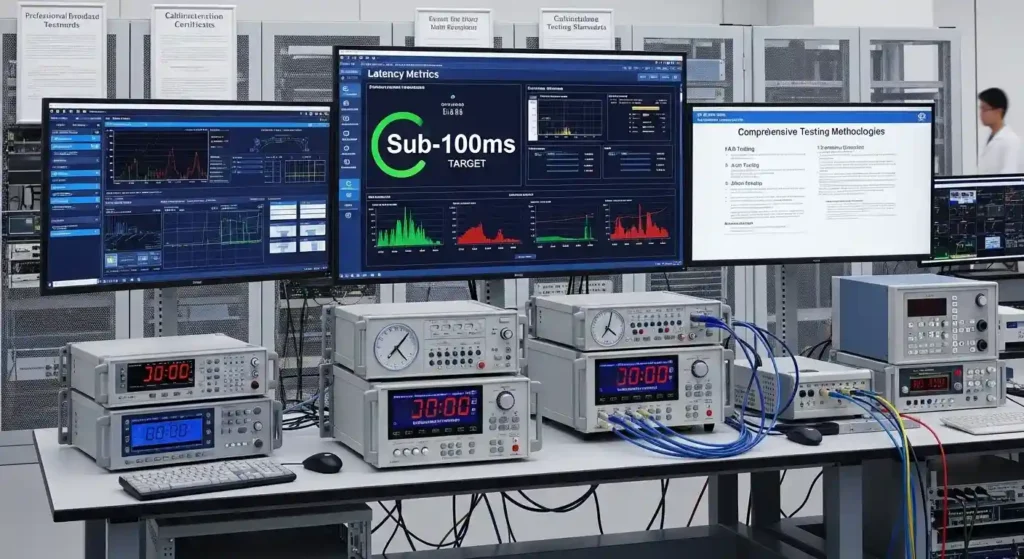
Latency specifications in marketing materials often reflect ideal laboratory conditions rather than real-world performance with network congestion, varying signal quality, and multiple concurrent streams. Request demonstration units or extended trial periods to test IPTV encoder over 2500 candidates under your actual operational conditions.
Establish comprehensive testing protocols that simulate peak usage scenarios including maximum concurrent streams, network congestion conditions, and input signal variations. Monitor latency consistency over extended periods rather than brief demonstrations that may not reveal performance degradation patterns. IPTV encoder over 2500
Professional Testing Framework:
- Establish baseline latency measurements for each supported protocol
- Test performance with maximum simultaneous stream counts under various quality settings
- Monitor latency stability during traffic spikes and network congestion scenarios
- Verify adaptive bitrate switching speed and quality transition smoothness
- Document any quality degradation patterns during extended operation periods
- Test failover performance and recovery times from connection interruptions
- Measure resource utilization and thermal performance under sustained loads
Consider testing encoders in your actual deployment environment rather than controlled laboratory conditions. Network characteristics, environmental factors, and infrastructure limitations can significantly impact performance in ways that laboratory testing may not reveal.
Tip 4: Evaluate Reliability and Redundancy Under High Traffic Conditions
Professional IPTV services demand consistent uptime regardless of concurrent viewer counts, network conditions, or equipment stress. Investigate encoder performance under sustained high-traffic conditions including network congestion, input signal interruptions, thermal stress, and power fluctuations that occur in real-world operations.
Research vendor reliability statistics including mean time between failures (MTBF) ratings, warranty terms, and replacement part availability. Quality manufacturers provide transparent reliability data and stand behind their products with comprehensive warranty coverage. IPTV encoder over 2500
Critical Reliability Assessment Criteria:
- Automatic recovery capabilities from various failure scenarios including signal loss and network interruptions
- Stream redundancy features and backup protocol implementation quality
- Component redundancy including power supplies, cooling fans, and network connections
- Remote management capabilities for monitoring and restart operations
- Environmental monitoring and alerting for temperature, power, and performance metrics
- Hot-swappable component support for maintenance without service interruption
- Firmware update procedures and rollback capabilities for problematic updates
Test failover capabilities thoroughly including both planned and unplanned interruption scenarios. Quality encoders should maintain service availability through various failure modes without requiring manual intervention.
Tip 5: Analyze Thermal Management and Power Efficiency Comprehensively
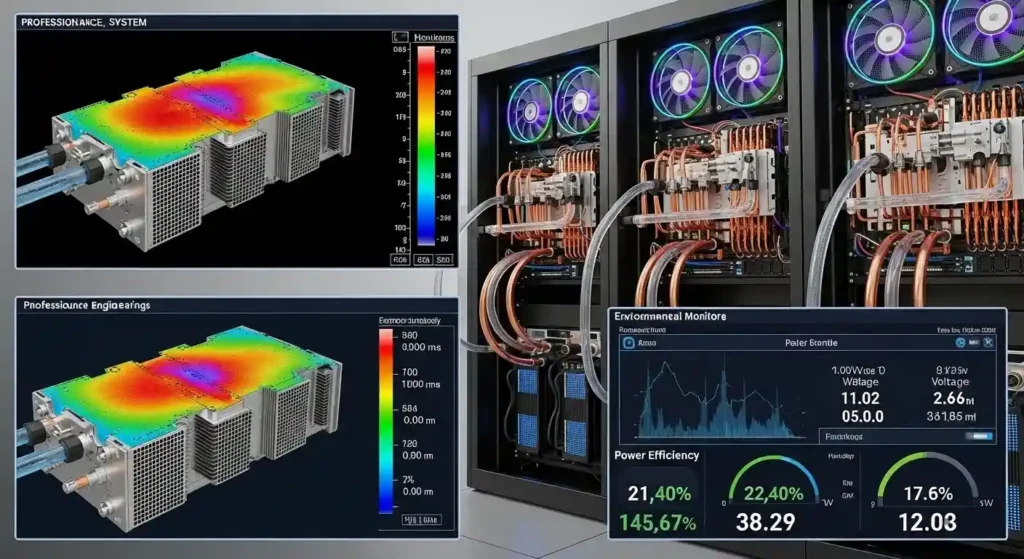
Thermal management directly impacts encoder longevity, reliability, and operational costs. Professional IPTV encoder over 2500 models require sophisticated cooling systems that maintain optimal operating temperatures during continuous operation while minimizing energy consumption and acoustic noise. IPTV encoder over 2500
Evaluate cooling system design including airflow optimization, component placement, and maintenance accessibility. Quality designs provide easy access to replaceable components like fans and filters without requiring complete unit disassembly or service disruption.
Comprehensive Thermal Evaluation Criteria:
- Maximum operating temperature ratings and thermal shutdown protection
- Cooling fan noise levels and acoustic design for studio environment compatibility
- Power consumption characteristics at various load levels and operating conditions
- Rack space requirements including ventilation clearances and cable management
- Environmental monitoring capabilities with real-time temperature and power tracking
- Intelligent thermal control algorithms that optimize cooling based on actual conditions
- Component accessibility for maintenance and replacement operations
Calculate total power costs including cooling requirements for your deployment environment. High-density installations may require additional facility cooling that significantly impacts operational expenses beyond the encoder’s direct power consumption. IPTV encoder over 2500
Tip 6: Assess Integration Compatibility with Existing Infrastructure
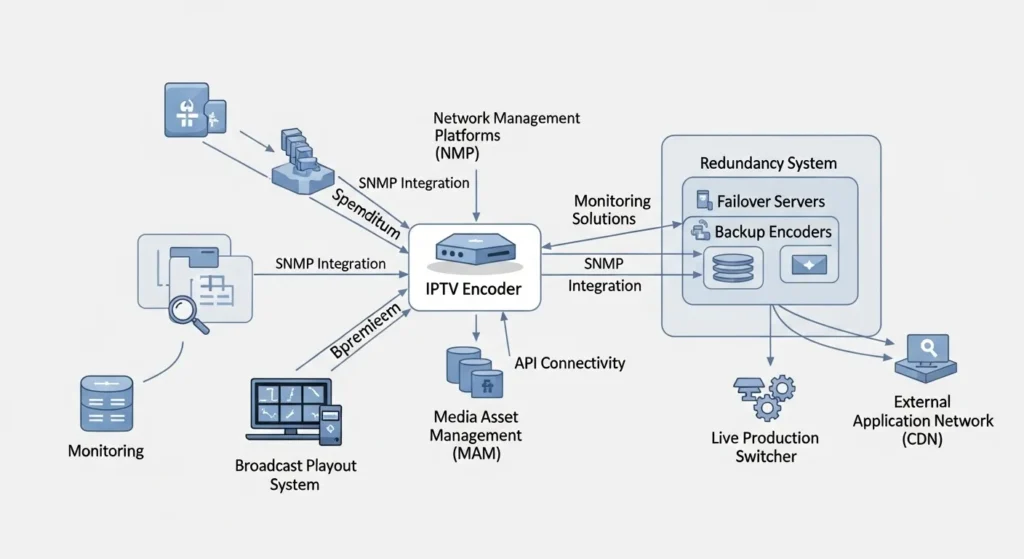
Seamless integration reduces deployment complexity, ongoing management overhead, and total cost of ownership. Verify compatibility with your content delivery network, streaming management software, monitoring systems, and workflow automation tools before making final purchasing decisions.
Modern IPTV encoder over 2500 systems should provide comprehensive API access for custom integrations and automation workflows. Well-designed APIs enable integration with existing operational procedures and reduce manual management requirements. IPTV encoder over 2500
Detailed Integration Assessment Framework:
- Content delivery network compatibility and optimization features for major CDN providers
- Streaming platform certifications and recommended configurations for popular services
- API documentation quality, SDK availability, and developer support resources
- Third-party monitoring system integration including SNMP and custom alerting capabilities
- Workflow automation compatibility with existing operational procedures and tools
- Configuration management tools for deploying settings across multiple encoder units
- User access control and authentication integration with existing security systems
Test integration capabilities thoroughly in your actual environment rather than isolated demonstrations. Complex integrations often reveal compatibility issues that don’t appear in simple testing scenarios.
Tip 7: Calculate Comprehensive Total Cost of Ownership
Initial purchase price represents only a portion of your long-term encoder investment. Develop comprehensive cost models that include all ownership expenses over your planned deployment period to make accurate comparisons between different IPTV encoder over 2500 options.
Consider financing options and depreciation schedules when comparing hardware versus software solutions. Some organizations prefer operational expenditure models while others benefit from capital equipment purchases depending on their financial strategies and tax considerations. IPTV encoder over 2500
Complete Cost Analysis Components:
- Hardware or software licensing fees including initial purchase and ongoing subscription costs
- Professional installation and configuration services from certified technicians
- Staff training and certification costs for operational and maintenance procedures
- Ongoing maintenance contracts, technical support agreements, and warranty extensions
- Facility costs including power consumption, cooling requirements, and rack space allocation
- Upgrade and expansion costs for capacity increases and feature enhancements
- Insurance and replacement planning for critical infrastructure components
Factor in opportunity costs of downtime and the value of reliability for your specific operation. Higher initial investments in quality equipment often provide better total returns through reduced downtime and maintenance requirements.
Common Mistakes to Avoid When Buying an IPTV Encoder Over 2500
Overpaying for Advanced Features You Won’t Utilize
Many IPTV encoder over 2500 models include sophisticated features that smaller operations never utilize effectively. Honestly assess your current and realistic near-term requirements to avoid paying premium prices for capabilities like advanced color correction, multiple codec support, enterprise-grade redundancy features, or specialized protocols you won’t need.
Strategic Feature Evaluation Methodology:
- Create detailed lists of must-have versus nice-to-have features based on actual operational requirements
- Research realistic upgrade paths and timeline for future expansion needs
- Compare feature-to-cost ratios across different models and manufacturers
- Verify that essential features work reliably as advertised through hands-on testing
- Consider leasing or rental options for expensive features needed only occasionally
However, avoid being too conservative in feature selection. Streaming requirements often expand faster than anticipated, and having unused capacity available can prevent costly upgrades when growth occurs. Balance current needs with reasonable expansion projections. IPTV encoder over 2500
Ignoring Critical Protocol Compatibility Requirements
Protocol mismatches create expensive integration headaches that delay deployments, frustrate technical teams, and potentially require additional equipment purchases to resolve. Thoroughly research your complete distribution network’s requirements and verify encoder compatibility across all current and planned streaming destinations.
The streaming industry continues evolving with new protocols and standards emerging regularly. Your IPTV encoder over 2500 investment should support firmware updates that add new protocol support without requiring hardware replacement. IPTV encoder over 2500
Protocol Compatibility Best Practices:
- Document all current streaming destinations and their specific protocol requirements
- Research planned expansion into new platforms and their technical requirements
- Verify protocol implementation quality through testing rather than specification review alone
- Confirm update procedures and costs for adding new protocol support
- Test interoperability with your specific CDN and streaming platform configurations
Consider future protocol needs as streaming standards continue advancing. WebRTC for ultra-low latency, AV1 codec support, and enhanced mobile streaming protocols are becoming increasingly important for competitive streaming services.
Underestimating Cooling, Power, and Environmental Requirements
Professional encoders generate significant heat and electromagnetic interference that require careful facility planning. Factor comprehensive cooling requirements into your deployment planning including ambient temperature limits, rack space allocation, power distribution, and acoustic considerations for studio environments. IPTV encoder over 2500
Environmental Planning Considerations:
- Calculate total heat generation including encoder and ancillary equipment
- Plan adequate rack ventilation and hot/cold aisle configurations for heat management
- Consider noise levels and acoustic treatment requirements for studio installations
- Evaluate power distribution capacity and backup power requirements for critical operations
- Plan for maintenance access and cable management in high-density installations
Inadequate environmental planning can lead to performance degradation, premature equipment failure, and costly facility modifications after deployment. Professional installation planning prevents these issues and ensures optimal long-term performance. IPTV encoder over 2500
Recommended IPTV Encoder Models for 2025: Detailed Analysis
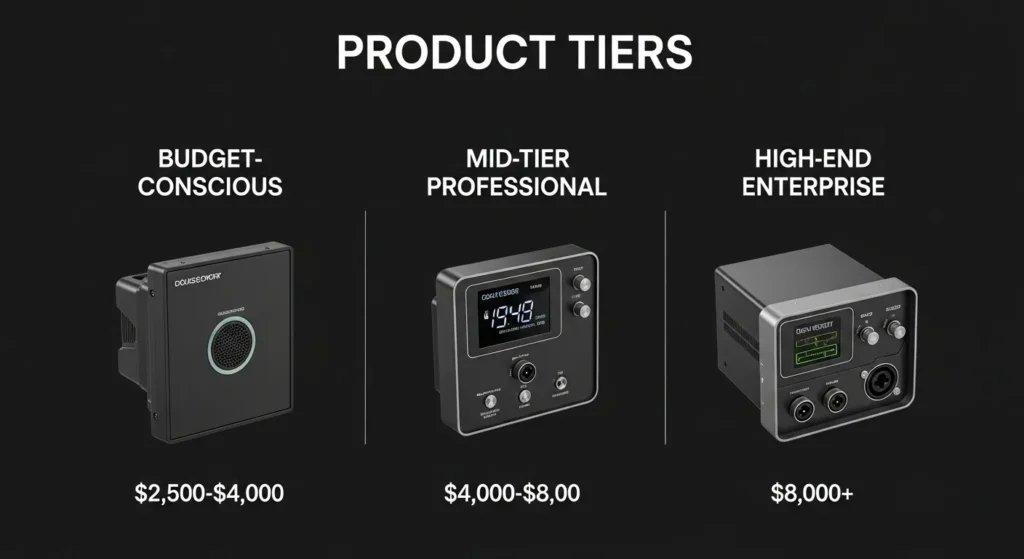
Budget-Conscious Options ($2,500-$4,000): Maximizing Value
Entry-level hardware encoders in this price range provide solid performance foundation for smaller IPTV providers, content creators, and organizations beginning their streaming journey. These units typically support essential protocols like RTMP and HLS while providing reliable operation for moderate traffic volumes without enterprise-grade pricing.
Key Performance Characteristics:
- Support for 2-4 simultaneous high-definition streams with quality bitrate configuration
- Basic protocol support covering RTMP, HLS, and standard MPEG formats
- Standard cooling systems adequate for normal operational environments
- Web-based management interfaces with essential configuration options
- Basic warranty coverage with email or phone support during business hours
Budget encoders often provide excellent value for operations with predictable streaming requirements and moderate growth expectations. However, carefully evaluate upgrade paths and expansion capabilities to ensure the investment aligns with realistic growth projections.
Consider certified refurbished units from reputable manufacturers as cost-effective alternatives to new budget models. Refurbished professional equipment often provides better long-term value than new budget units while including warranty coverage and vendor support.
Mid-Tier Professional Choices ($4,000-$8,000): Balanced Performance
Mid-range encoders provide optimal balance between comprehensive feature sets and cost-effectiveness for growing IPTV operations. These models typically include advanced protocols like SRT, enhanced redundancy features, improved cooling systems, and professional management tools suitable for medium-scale commercial deployments.
Enhanced Professional Features:
- Support for 8-16 simultaneous streams with advanced quality control
- Comprehensive protocol support including SRT, WebRTC, and DASH formats
- Advanced thermal management with intelligent cooling and monitoring
- Redundant power options and failover capabilities for improved reliability
- Professional management tools with API access and automation capabilities
- Extended warranty options with priority technical support and replacement services
Mid-tier encoders often provide the best long-term value for operations expecting steady growth and increasing feature requirements. The additional investment in capabilities and reliability typically pays dividends as streaming operations mature and audience expectations increase. IPTV encoder over 2500
High-End Enterprise Units ($8,000+): Maximum Capability
Enterprise-grade encoders provide maximum reliability, performance, and feature sets for demanding broadcast environments, large-scale IPTV providers, and mission-critical streaming operations. These units include advanced redundancy systems, comprehensive monitoring capabilities, and support for specialized protocols required by professional broadcasting and large-scale commercial deployments.
Enterprise-Grade Capabilities:
- Hot-swappable components enabling maintenance without service interruption
- Advanced stream redundancy with automatic failover and load balancing
- Comprehensive real-time monitoring with predictive failure analysis
- Support for specialized broadcast protocols and professional equipment integration
- 24/7 technical support with guaranteed response times and on-site service options
- Extended warranty coverage with advance replacement and priority support
Enterprise encoders justify their higher cost through superior reliability, advanced features, and comprehensive support that reduces total cost of ownership for large-scale operations. These units provide the foundation for professional streaming services that compete directly with traditional broadcast television.
Final Verdict: Making a Smart, Future-Proof IPTV Encoder Over 2500 Investment
Selecting the optimal IPTV encoder over 2500 requires careful balance between current operational needs and future growth projections while maintaining cost-effectiveness and reliability standards. The seven comprehensive tips outlined in this guide provide a systematic framework for making informed decisions that align with your technical requirements, business objectives, and budget constraints.
Remember that proper setup quality, configuration optimization, and ongoing maintenance often determine performance more than the specific encoder model selected. Even premium hardware encoders will underperform if improperly configured, inadequately cooled, or neglected during operation. Invest adequate time and resources in professional installation, comprehensive staff training, and proactive maintenance programs to maximize your encoder investment returns.
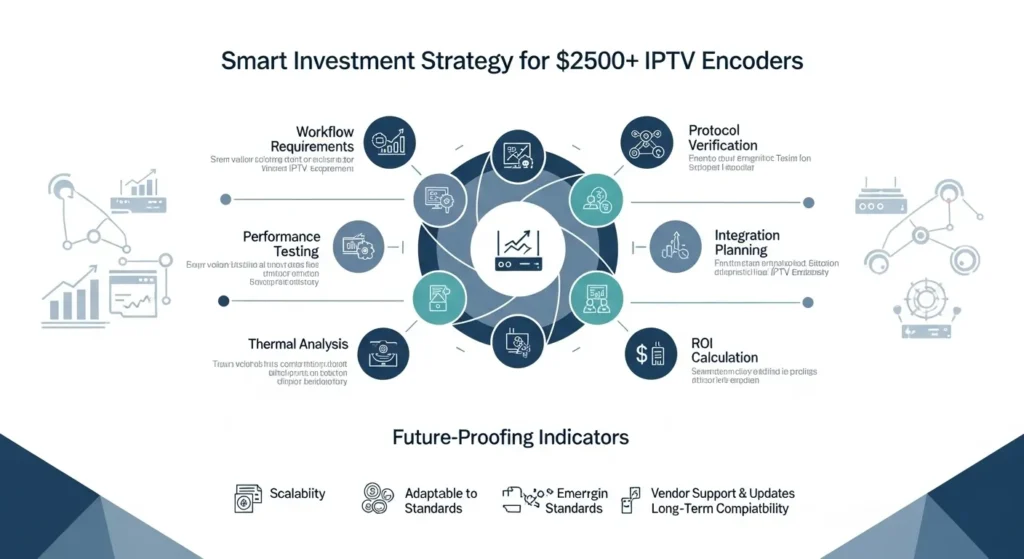
Maintain active relationships with your encoder vendor’s technical support team and stay informed about firmware updates, protocol developments, and industry best practices. The IPTV industry continues evolving rapidly with new technologies, standards, and viewer expectations, making ongoing education and system updates essential for maintaining competitive streaming services. IPTV encoder over 2500
By following these proven selection criteria, avoiding common purchasing mistakes, and implementing professional deployment practices, you’ll choose an IPTV encoder over 2500 that delivers reliable performance, supports your growth plans, and provides excellent long-term value for your investment in professional streaming infrastructure that serves your audience effectively. IPTV encoder over 2500

